Who Is Harry Souttar?
At 198cm (6’6”), 79kg (174lbs), Harry Souttar makes for a very distinct presence on the football pitch.
Throughout any given game, the 23-year-old Australia international (who was born in Aberdeen), generally stands out in more ways than just that, however, which I’ll discuss in this scout report.
Souttar plies his trade for Stoke City, who finished last season in the bottom half of the EFL Championship but currently look like potential playoff contenders under former Shamrock Rovers and Northern Ireland manager Michael O’Neill, who’s been in charge of The Potters since November 2019.
Souttar has been at the Staffordshire-based club since 2016 when he made his move from Scottish Premiership side Dundee United.
The towering centre-back started to make a name for himself at first-team level in England back in the 2019/20 campaign, during a loan spell with Fleetwood Town in England’s third tier.
Last term, he returned to Stoke and cemented himself as a first-team regular in England’s second tier, as he ended the Championship campaign having accumulated more league minutes (3417) than any other Stoke City player.
Souttar’s availability is one of his most notable assets.
The Australian defender has managed to avoid any serious injury issues during the early stages of his career and over the last calendar year, at the time of writing, he’s played 4431 league minutes, the 12th-most of any Championship centre-back.
As his size would suggest, Souttar’s aerial ability is another notable quality of his.
The 23-year-old also shines in terms of passing ability and reliability in defensive duels while he also routinely makes a high number of interceptions.
With all of this in mind, it’s not difficult to see why Australia manager Graham Arnold recently went so far as to declare that the centre-back: “is definitely going to be in the Premier League” in the future — a view that I’m also happy to endorse should he continue in England.
This tactical analysis will explore the aforementioned strengths in this promising centre-back’s game, as well as some notable areas of improvement.
Along with insight into Souttar’s role within O’Neill’s tactics at Stoke, I aim to provide a clear, in-depth analysis of all Souttar’s game through this scout report.
Harry Souttar Style Of Play
To kick off our analysis, I’m going to focus on the somewhat obvious asset that is Souttar’s aerial ability.
At 198cm, he’s going into most games with a great physical advantage over opposition attackers and this has several benefits for him and his side, which will be explored in this section.
Firstly, although they didn’t all come against the greatest opposition, his six goals in five international appearances for Australia — all of which came via headers at set-pieces — show that Souttar is, indeed, a serious threat at set-pieces.
In an era when the appreciation for set-pieces is growing, this makes him a valuable tool.
The Stoke City man engages in plenty of aerial duels.
The majority of his aerial duels come when the opposition sends a long ball upfield and knowing Souttar’s obvious physical advantages, teams may try to play long balls into areas unoccupied by the big Australian.
As a result, he hasn’t been engaging in a ridiculous number of aerial duels like you might suspect on first thought based on the fact that this is likely to be Stoke’s preference.
In the league over the last 12 months, he’s been in 7.86 aerial duels per 90 — which is still a very healthy number.
Souttar stands out here in terms of his aerial duel success, though, which stands at a very impressive 73.39% for the last 12 months.
Concerning his role in Stoke’s side, last season, Souttar primarily played as the right centre-back, mostly in a back-three, though sometimes in a back-two.
He’s right-footed but did also get some game time at left centre-back last term.
This season, however, Souttar has primarily played in the centre of The Potters’ back three and when playing in a back-three, I feel this is the 23-year-old’s most suitable role.
In a back-two, I’d advocate for the Australian to line up on the right side as I don’t think playing on the left — as he did in Australia’s recent international games versus Japan and Oman — gets the best out of him at all.
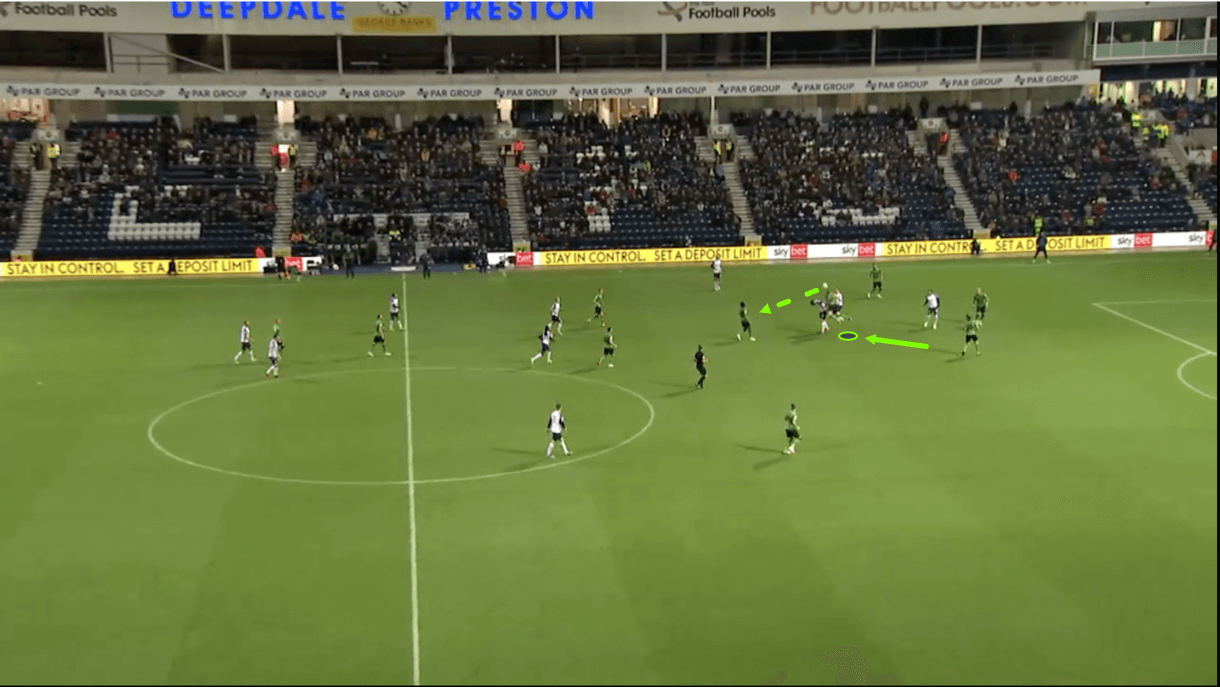
This season, Souttar has been stepping out of the backline a lot to contest aerial duels, which we see an example of in figure 1.
As previously mentioned, teams aren’t going to be particularly excited about contesting aerial duels versus the 198cm centre-back, while Stoke will be happy to see Souttar contesting lots of aerial duels so to combat teams playing the ball into areas unoccupied by the Australian, the Stoke man enjoys some freedom to roam around in front of the backline when long balls come from the other end of the pitch.
He essentially seeks out aerial duels in a typical holding midfielder’s position in front of the backline, while the left and right centre-back on either side of him get closer to protect the space opening up in the backline as a result of Souttar’s movement.
This freedom is more easily granted to the central centre-back as the two centre-backs on either side of him can quickly react to the movement of the man next to them and get close to guard against space opening up, while Souttar, being centrally located, is in a prime location to get himself involved in an aerial duel in more locations than if he were playing on the right and the aerial duel were on the left as he’d have more ground to cover in this scenario.
Souttar’s impressive aerial duel success rate speaks for itself but it’s still worth noting how, in figure 1, the Australia international holds his ground and successfully beats two opposition players to the ball despite one jumping into him at pace from the side.
He can be very difficult to move, as this image suggests; this strength, along with his size, helps him to succeed in aerial duels.
When he roams into the drop zone and plants his feet down to contest the aerial duel, it can be like a brick pillar being planted on the pitch for the opposition to deal with.
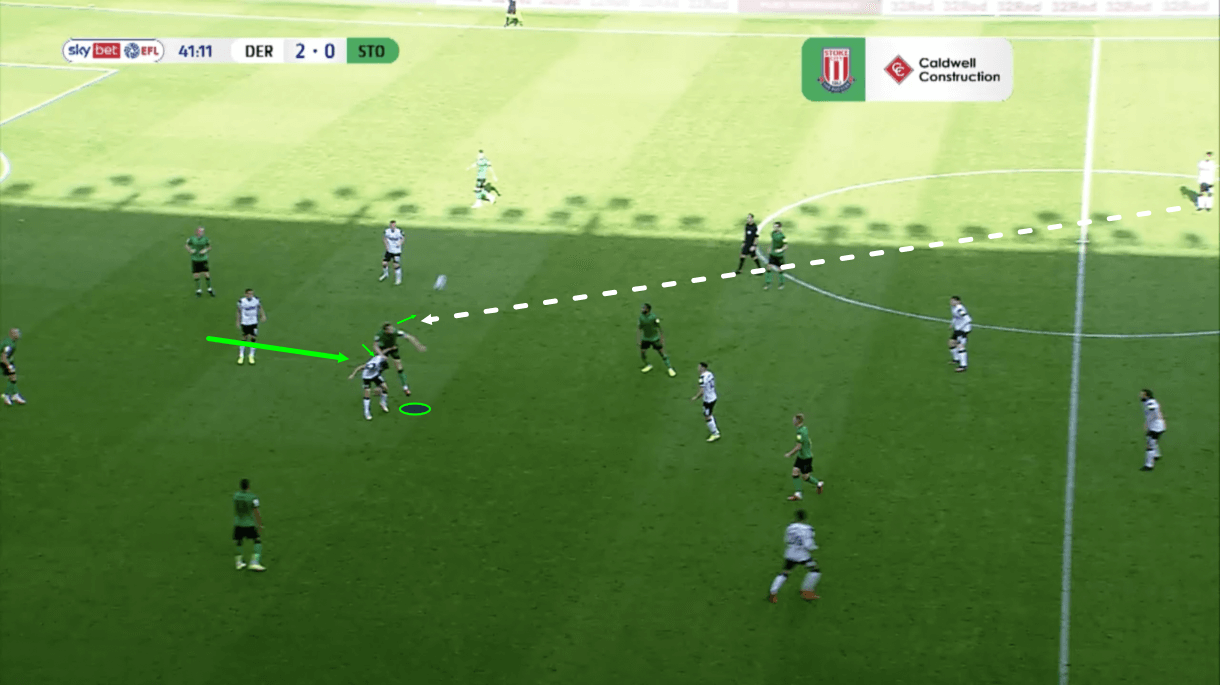
Figure 2 provides an example of a typical Souttar aerial duel, including an effective technique that the centre-back routinely uses when engaging in aerial duels.
Just before this image, the opposition goalkeeper sent the ball upfield towards this forward while Souttar sprung into action and pushed out from the back to get into this position to contest the aerial duel.
Souttar doesn’t just rely on his size to win aerial duels.
The 23-year-old is good at creating all of the advantages he can.
Souttar is good at physically imposing himself on opposition players, as we see in figure 2.
One technique he regularly uses to do this is: throwing an opposition player off-balance by leaning on one arm during his jump.
This is what we see him doing in figure 2, which has two positive results: he stifles the opposition player’s attempted jump and he throws them off-balance to significantly increase his chances of coming out on top of this aerial duel even further.
Souttar is good at being subtle with this technique, which is key to its success.
He doesn’t want to push the opposition player to the ground, just unbalance them which requires less force.
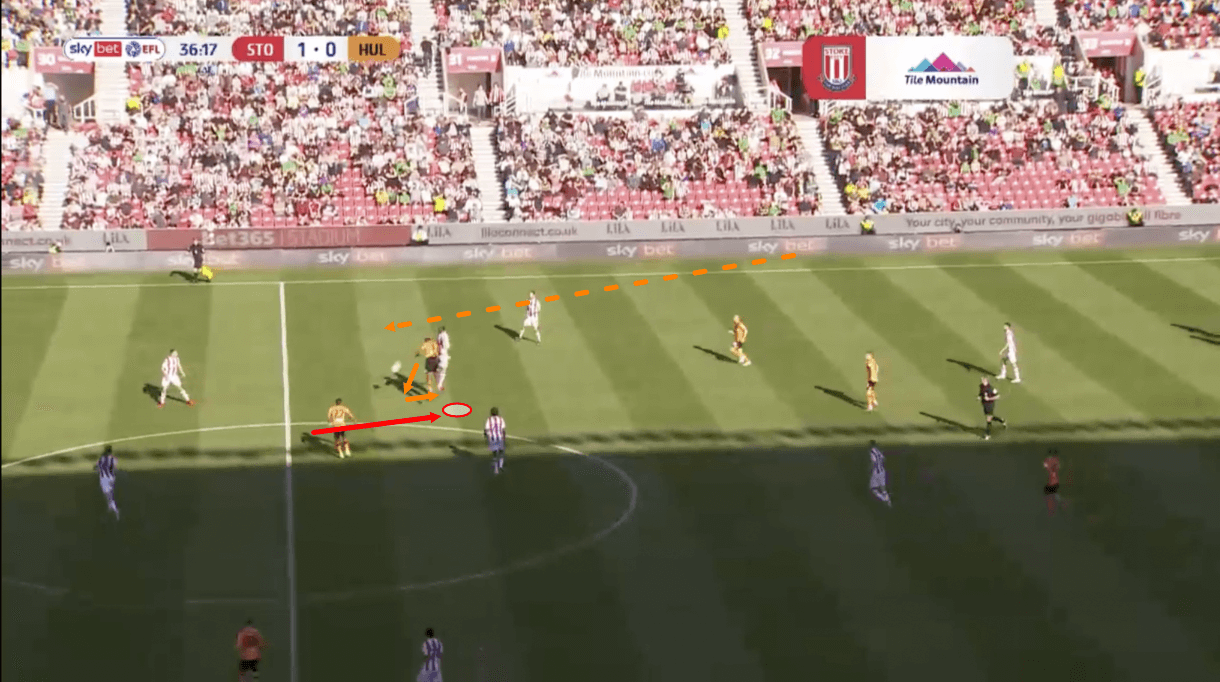
Obviously, despite his undeniable skill in this area, Souttar doesn’t win 100% of his aerial duels.
One reason for this is that, at times, he advances too high on the pitch which gives opposition players a chance to unsettle him.
In figures 1 and 2, we saw Souttar successfully win an aerial duel, getting tight to an opposition player from behind; this is a good way of entering the aerial duel as it gives the opposition player no space to get away from the Stoke City centre-back and Souttar can also physically manipulate the opposition player from this position, as we saw in figure 2, to increase his chances of success.
However, in figure 3, we see an example of an occasion when Souttar advanced too far forward while stepping out of the backline, which resulted in an unsuccessful aerial duel.
This highlights the importance of timing, which is key when attacking any aerial ball.
Again, Souttar’s aerial duel record, in general, over the last 12 months has been fantastic so this isn’t to say he has bad timing but if you were to point out an area in which he could look to make any small improvements, this may be one.
When behind an opposition player, he can use them as something of a reference point when contesting an aerial duel.
He’s very difficult for players to back into thanks to his size and strength so he is good at standing his ground when behind an opposition player and this generally helps him to get his timing spot on.
In figure 3, he doesn’t get the timing spot-on as he advances too far forward, giving an opposition player a chance to get in behind him and subtly drive his hips into Souttar to continue the big centre-back’s forward momentum, leading to the ball dropping behind him.
This wouldn’t happen if the opposition player weren’t initially given the chance to get behind Souttar and the failed aerial duel occurs due to a combination of Souttar’s decision to advance so far leading to poor timing and the opposition player’s intelligent decision to get behind Souttar and get away with driving his hips into him to continue his forward movement.
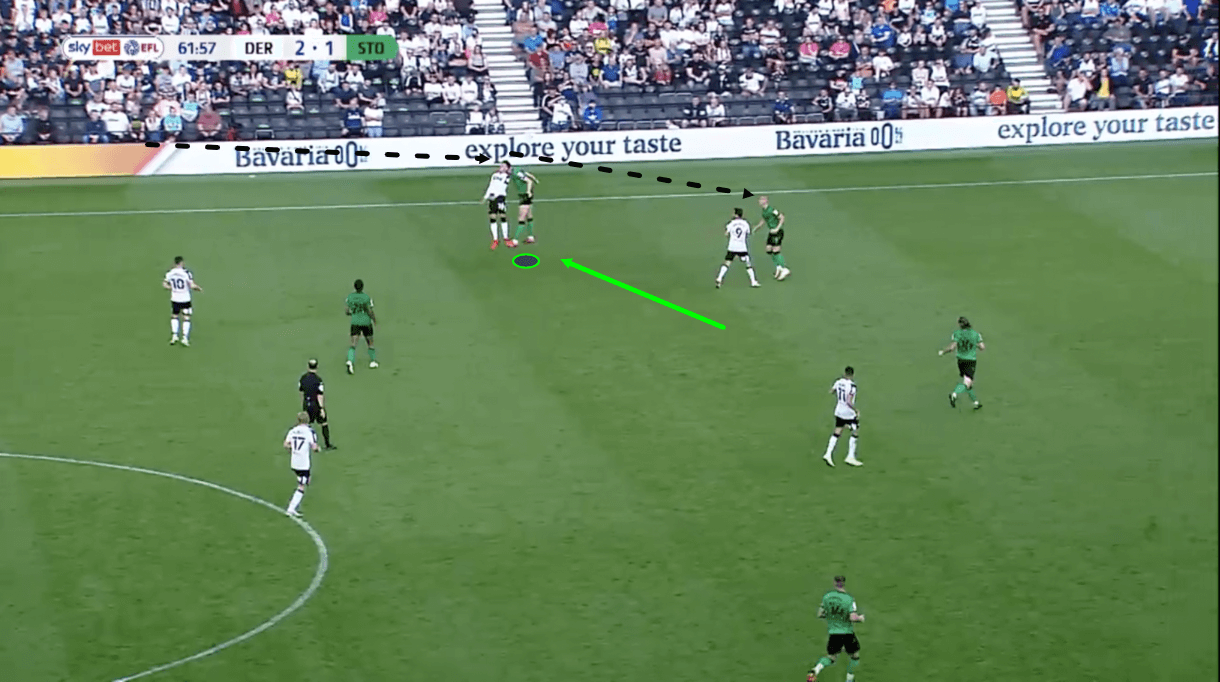
In figure 4, we see another rare unsuccessful Souttar aerial duel.
The big Australian is circled and here, unlike in figure 3, we see that he is behind the opposition player as usual, rather than in front of them, which is good.
However, on this occasion, Souttar is slightly too far behind the opposition player, partly as a result of the fact that he had to move from his central centre-back position to what is essentially a traditional right-back position to contest this aerial duel.
Here, the Australia international isn’t tight enough to the opposition player.
He’s not in a position to stifle their jump as he did to his opponents in figures 1 and 2, which allows this player to spring up in front of Souttar and knock the ball on for a teammate to chase.
This example highlights how important it is for Souttar to get tight to players and physically impose himself on them despite his physical advantages.
He’s generally very good at taking all of the advantages he can to win aerial duels, which includes physically dominating opposition players.
When he doesn’t do so, that can lead to unsuccessful aerial duels as we see here so the Stoke City man must try to avoid situations like this and if he can do so to a greater extent, then he may be able to improve his already stellar aerial duel record.
Harry Souttar Passing quality
The Australian centre-back isn’t just a formidable force in the air, he also poses a significant threat to the opposition on the ball.
This makes Souttar an excellent asset for his side during early possession phases.
Firstly, the Stoke City man is generally heavily involved for his side during possession phases.
He doesn’t carry the ball out from the back a lot, with teammates like Ben Wilmot and Leo Skiri Østigård performing far more progressive runs and dribbles than him.
Souttar is comfortable with carrying the ball if necessary — for example if under high pressure with all passing options blocked off — but this isn’t where he’s at his most comfortable and he is susceptible to taking heavy touches at times when dribbling, which isn’t ideal in the centre-back position.
As a result, he doesn’t carry the ball a lot.
The area of passing is where he truly shines on the ball.
He’s completed 45.96 passes per 90 in the last calendar year, which ranks very well amongst Championship centre-backs.
However, Souttar doesn’t perform very well in terms of passing accuracy, having completed just 83.16% of his passes in the last calendar year.
This issue of pass completion isn’t indicative of sloppiness, however.
It is indicative of the fact that Souttar is an extremely progressive centre-back who plays an important role in driving his team upfield.
Over the last 12 months, Souttar has played a very low number of backwards passes, even for a centre-back (2.23 per 90), but with very high accuracy (96.36%).
Meanwhile, he’s played a decent number of lateral passes (20.39 per 90) also with very high accuracy (95.92%).
The rest of his passes (20.45 per 90) have been forward passes and this is where he sacrifices accuracy (68.72%) more for opportunities to get the ball into high-value areas.
This is, of course, risky but it’s part of what makes Souttar such a valuable asset for The Potters.
Souttar has played 10.72 progressive passes per 90 in the last 12 months which ranks him ninth in this metric among Championship centre-backs to have played at least 800 minutes in that time (a total of 136).
He’s managed to achieve a relatively good progressive pass accuracy rate of 73.67% with these passes.
This will lead to his overall passing accuracy decreasing because the nature of these passes is riskier than if he’d just been playing more lateral passes.
As his lateral and back pass accuracy suggest, he’s capable of playing safe and keeping the ball if necessary but that’s not his role — he plays an important role at Stoke in conducting play from deep and regularly putting his team in more valuable positions in early possession phases.
His progressive pass accuracy is good, as far as progressive pass accuracy goes; this indicates that Souttar is reliable in his role and goes some way to showing that Stoke are getting plenty of high-quality progressive passes from the 23-year-old.
Souttar also plays a lot of long passes, which is another reason why his overall pass accuracy drops off to an extent.
Souttar has played more long passes (9.81 per 90) than any other Championship centre-back to have played at least 800 minutes in the league over the last 12 months.
This is a trademark of his game.
Again, these passes will naturally be riskier than others, which leads to his overall pass accuracy taking a hit, but in general, Souttar performs well in terms of long pass success.
He’s managed 57.97% long pass accuracy for the last 12 months which is very high compared to other Championship centre-backs in the last 12 months although he’s played more of them than any other centre-back.
This shows the extent of his quality on the ball.
Stoke City are getting high-quality long passes from Souttar.
So, it’s clear that there are plenty of areas in which he stands out a lot on the ball and while his passing accuracy, on the surface, doesn’t stand out, he is very reliable on the ball, being relied upon to perform a deep playmaker role for The Potters in which he can put his wide range of quality passing ability on display.
This section of analysis will now dive into four of what you might call Souttar’s ‘signature’ passes, before moving on to one key weakness within the centre-back’s passing game.
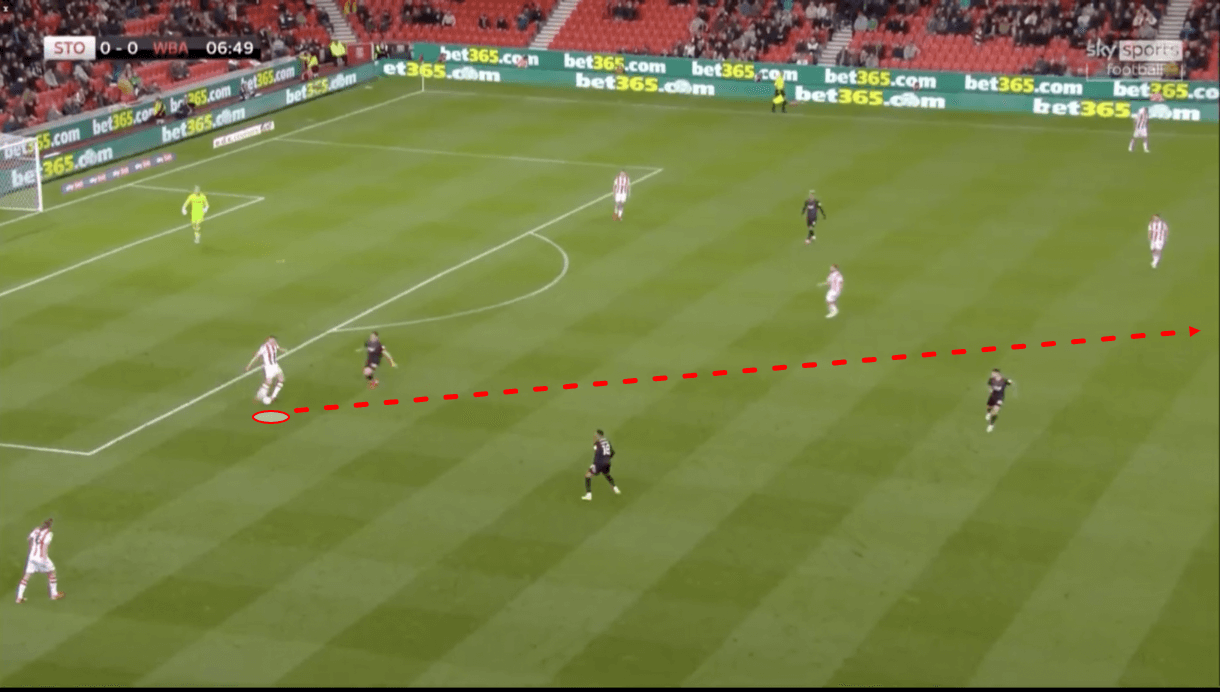
As mentioned previously, long passes are a particularly notable fixture of Souttar’s passing game, with the Stoke man playing more than any other Championship centre-back with over 800 minutes in the last calendar year.
His positive long passing accuracy reinforces the point that these are well and truly ‘long passes’; he’s not just lumping the ball upfield or clearing it away most of the time, he’s picking out teammates in far more advanced areas and allowing them to attack.
Some key attributes of Souttar’s that helps him to be such a reliable long passer are his vision and his ability to gently glide the ball forward in search of a teammate with good accuracy.
The Stoke centre-back is excellent at putting only the necessary amount of power on the ball, weighing his passes expertly.
These attributes will be on display in the next passage of play we’ll analyse, beginning with figure 5.
Here, we see Souttar in possession in the right centre-back position, just on the edge of his box.
He’s under aggressive pressure from an opposition forward here, but that doesn’t stifle him while playing out from the back and attempting to pick out the right pass that gets his team moving forward.
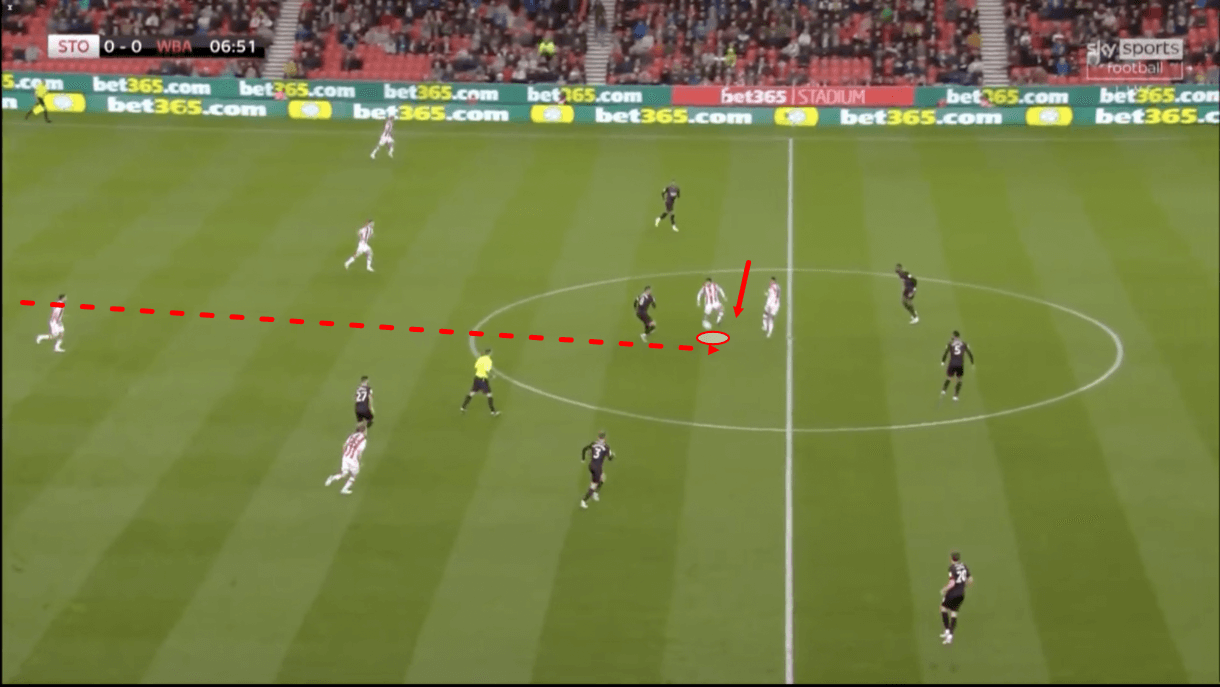
After picking out his pass by spotting and reacting to his teammates’ movement ahead of him, Souttar glides the ball forward lightly with a bit of backspin, lifting it over the opposition’s midfield line and landing it at the feet of his teammate between the lines, as shown in figure 6.
The accuracy and light weight of Souttar’s pass land it right into his teammate’s running path and make it easier for the receiver to control.
As play moves on, the player between the lines can quickly attack the opposition’s backline, along with the runner beside him.
This highlights the benefit of Souttar’s long passing quality for The Potters.
It’s really impressive that Souttar can perform accurate long balls with this light weight as seen in figures 5 and 6 with such regularity.
The centre-back can quickly get his team in a far more threatening position thanks to his mental and technical skill on the ball, both of which are on display in this example, which is why he plays such a prominent role in his side’s ball progression.
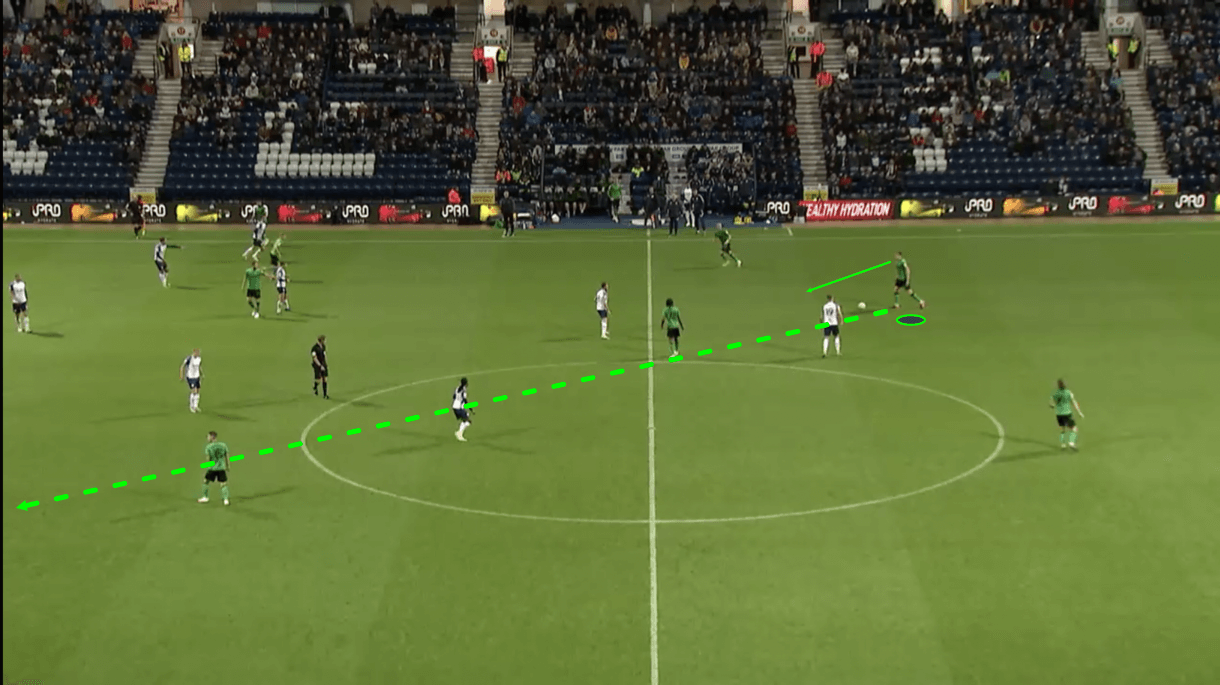
One trademark of Souttar’s game is long switches of play from one side of the pitch — typically the right centre-back position — to a very wide player on the opposite wing.
Again, the centre-back’s vision, passing accuracy and ability to put just the right amount of power on his passes stand out as key attributes that help him to perform these types of passes so well.
Figure 7 shows an example of Souttar lining up a switch of play from the right centre-back position to a teammate advancing on the left-wing.
The opposition doesn’t press the Australia international here, which gives him way too much time to pick out his pass and ultimately execute it with the high-level technical ability we know he possesses.
Souttar is not the man you want to allow to enjoy all of this time and space on the ball, but his deep position allows him to enjoy this time and space enough that he can pull off passes like the one on display here frequently.
Even when under pressure, Souttar is capable of executing his passes very well, as we saw in figures 5 and 6, but he’s more susceptible to poor decisions and mistakes when pressed more aggressively too.
While this opens the possibility of the centre-back exploiting space opened up by the press, it also increases the possibility of forcing Souttar into a poor decision/a mistake, which can be capitalised on by the pressing side in the form of a dangerous counter-attack.
Souttar can be reluctant to just clear the ball when there aren’t many good passing options, even when under pressure.
As a result, he can be pressed into mistakes but, again, this does come with a risk.
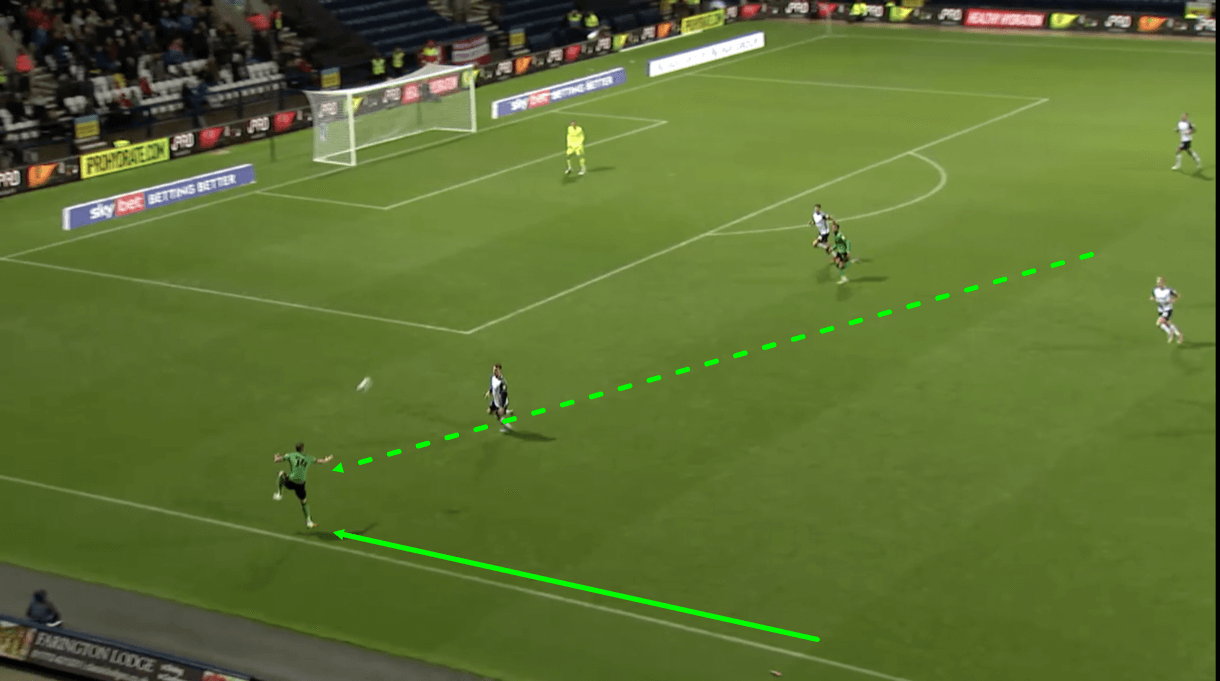
As play moves on into figure 8, we see that Souttar’s long pass finds the intended target wide on the left wing perfectly.
The pass arrives at a perfect height and without too much power so the receiver can cushion it with the inside of his left foot before attacking the box.
Again, the accuracy and weight of this pass are what stand out for me, as well as the impressive regularity with which Souttar can play these passes with this same technique and level of quality.
Souttar’s consistency with his long passing quality is a big part of why this pass has become something of a trademark in his game.
He’s comfortable with playing these passes a lot and Stoke City accommodate that by setting up opportunities for him to hit it, like this one.
This is an excellent tool for Souttar and his team when switching from an overloaded wing to an underloaded wing to set a free player off in behind the opposition’s backline via the wide area.
This then creates 1v1s and then it’s up to Stoke’s wide men to showcase the necessary dribbling quality to beat their man.
They can generally rely on Souttar to provide perfect service before the dribble, however.
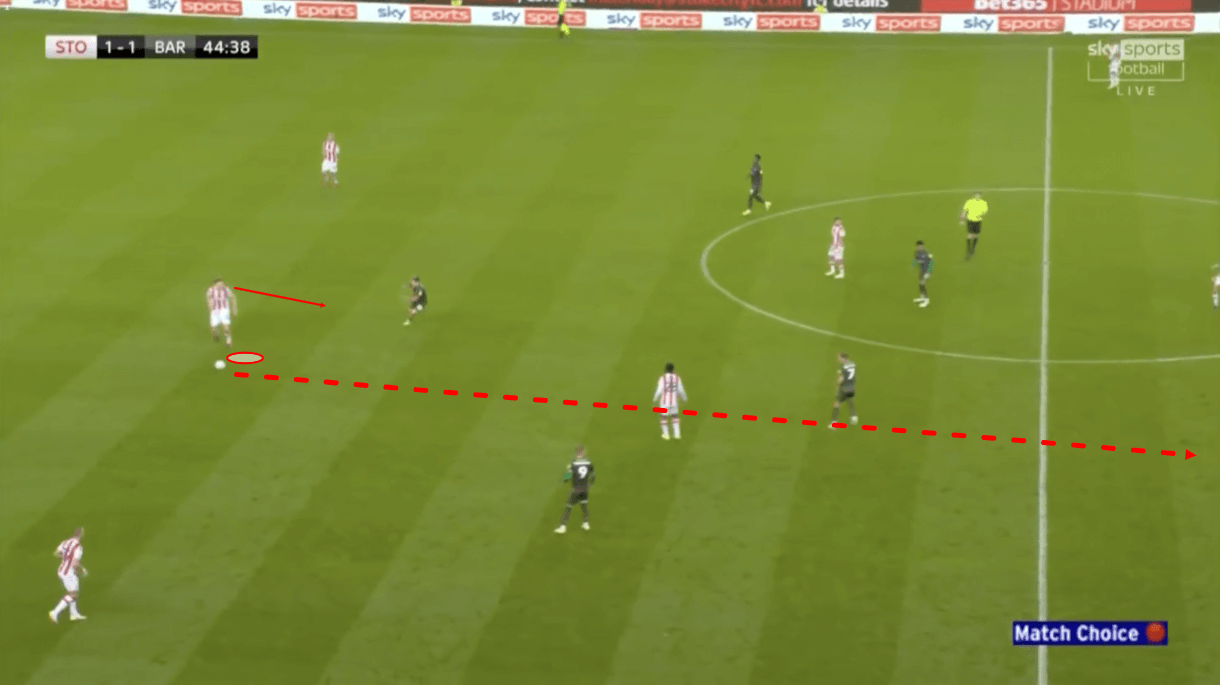
Another of Souttar’s trademark passes is a driven lofted through ball played over the opposition’s backline for a runner to chase in behind.
We see Souttar play the passes seen in the previous two examples a lot more; he doesn’t send players in behind the backline a lot, preferring to play passes to player’s feet or play big switches of play across the pitch.
However, at times, he likes to send teammates in behind the opposition’s backline if possible.
We see the start of a passage of play in which this was the case in figure 9.
Again showing a preference for the right side of the pitch, Souttar enjoys enough time and space to spot his teammate’s run up the right-wing and line up his lofted through ball.
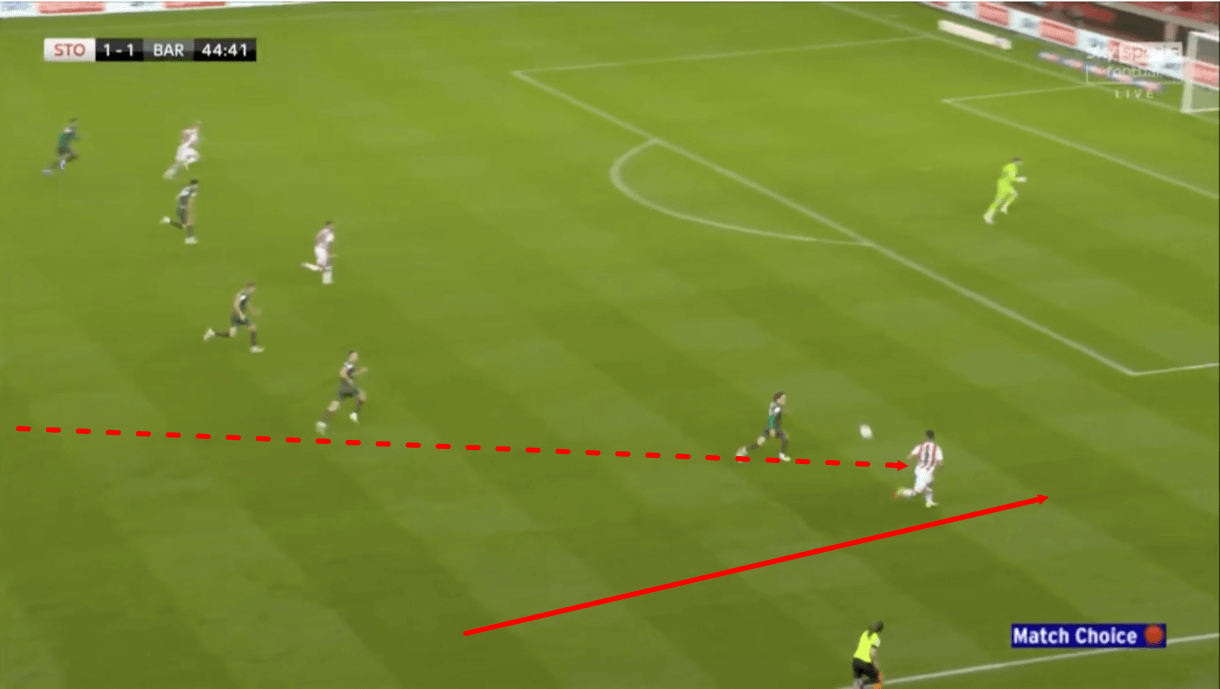
As play moves on into figure 10, we see that this lofted through ball is, again, accurate and well-weighted as it drops right into the runner’s path, setting him off in behind the opposition’s backline on the right-wing with two teammates speeding into the box more centrally ahead of the opposition’s defenders.
This pass differs from the previous two we’ve analysed because Souttar plays the ball with a bit more power.
He can afford to put more power on the ball here because the teammate is running forward into space, so Souttar has more space to work with as he plays the pass and intelligently uses that space to send the runner in behind the backline.
This highlights the danger of playing a high line against Souttar.
He’s capable of picking out runners in behind quickly thanks to his excellent vision and executing the lofted through ball well despite opposition pressure.
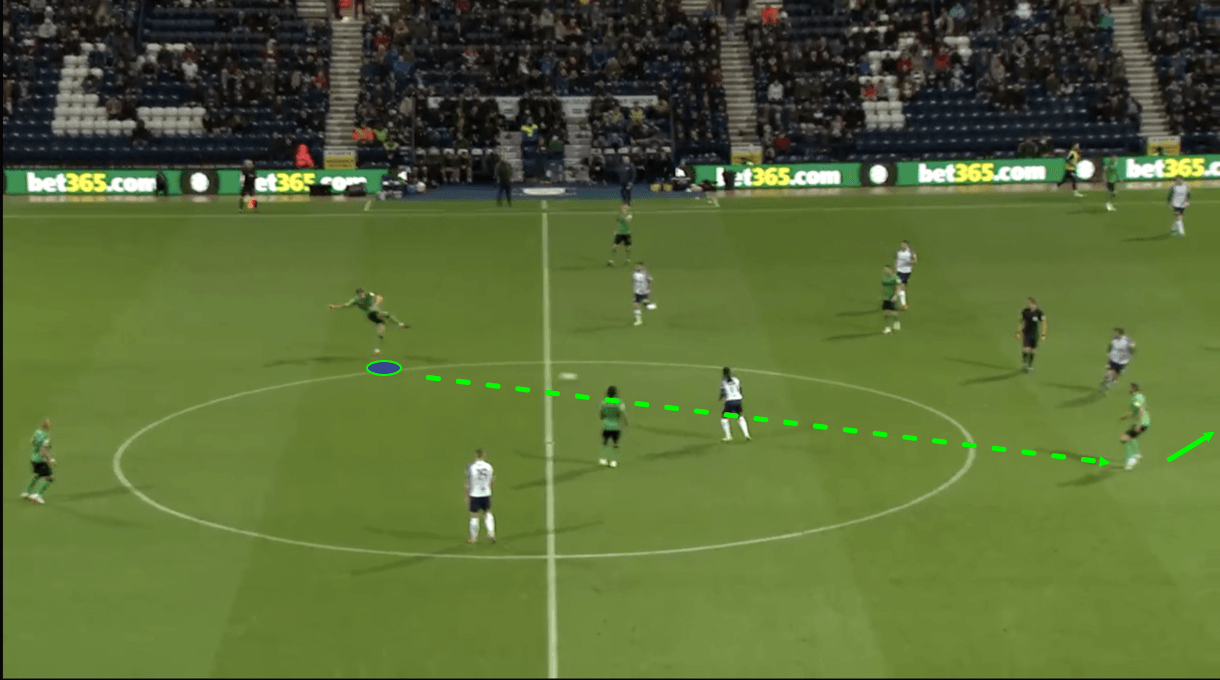
Of course, Souttar doesn’t just play long balls, although they are a significant part of his game.
He also progresses the ball through the lines with shorter passes a lot, which we see an example of in figure 11.
Here, Souttar is positioned closer to the left side of the pitch but approaches the pass with the ball on his stronger right foot and with open body orientation.
This opens up the possibility for the centre-back to play the ball into the centre.
Again, the opposition doesn’t put enough pressure on the 23-year-old here, allowing him to react to his teammates’ movement ahead of him in the centre well and send this ball along the ground into a central teammate well inside the opposition’s half.
When playing these progressive passes along the ground, Souttar generally retains his accuracy but tends to put plenty of power on the ball.
He doesn’t hoof the ball into his teammates but he does fizz the ball along the ground nicely with plenty of pace.
This generally still allows the teammate to control the ball without many issues while helping Stoke to get forward quicker, avoiding opposition players who’d like to intercept.
The pace on the ball gives the receiver the option of using that pace to receive on the half-turn before quickly moving forward, while the accuracy and weight of the pass still give the receiver the option of taking the pace out of the ball to slow the game down and assess his options before moving on.
It’s common to see the Stoke centre-back play these pacey, accurate passes along the ground into central areas.
When not playing long balls, he loves to get the team moving forward through the centre and his excellent technique helps him to do that.
This is one occasion where Souttar is good operating on the left, as he can naturally open his body to the centre but he’s also good at playing these progressive passes into the centre from the right.
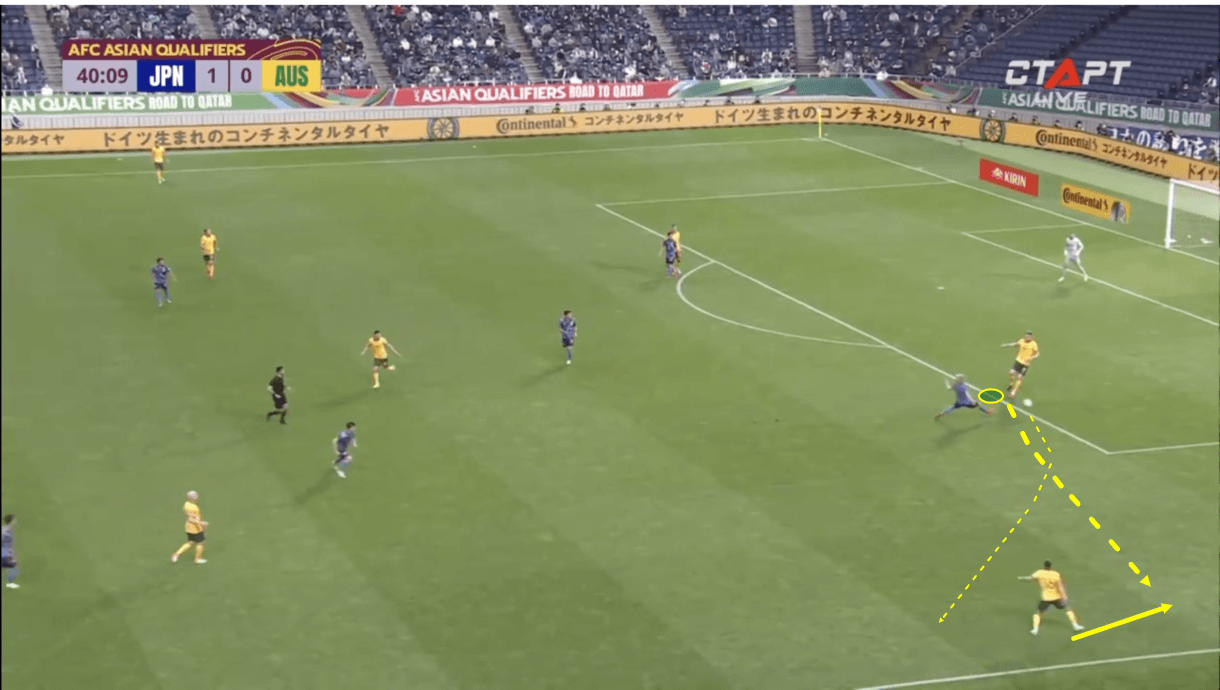
One key negative in Souttar’s game on the ball is his one-footedness.
We see an example of this in figure 12, which is taken from a game where the Australia centre-back was used on the left of a back-two.
Here, Souttar was put under pressure, making it difficult for him to pick out/execute a long pass, while all of the decent short passing options to his right were either marked out of contention or blocked off entirely.
This leads to Souttar having to turn to his left and opt for a pass out to the left-back.
If he were more comfortable with using his left foot, Souttar could shift the ball onto his left foot here and bend a pass in front of the left-back, which is depicted here via the smaller dotted line.
However, the centre-back avoids using his weaker left foot, instead opting to stick with his stronger right foot.
This is fine and the pass does reach the intended target but coming from his right foot, the ball has to bend behind the left-back, forcing the receiver to turn back towards his own goal and move backwards to control the ball.
This pass is an obvious natural negative result of the ball coming from the passer’s right foot rather than his left foot.
The pass reaches the intended target but stifles the team’s progression to an extent, forcing the receiver to move backwards and receive with his back to the opposition’s half.
Souttar’s one-footedness and the obvious negative results under pressure is one reason why he is uncomfortable when playing on the left in certain situations and why I’d argue he’s far better suited to the right.
However, the player’s one-footedness and the negatives of it aren’t exclusive to playing on the left.
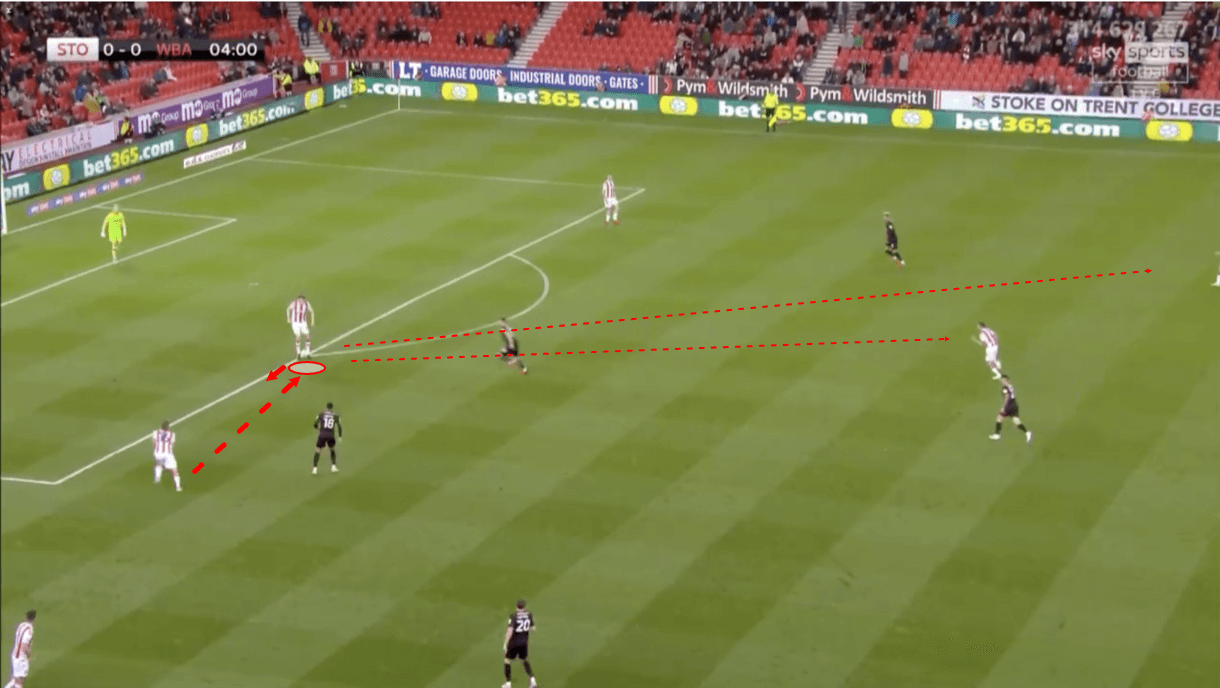
Figure 13 shows an example of how Souttar’s one-footedness can also be exposed in the central centre-back position or the right centre-back position.
Just before this image, the Australian received a pass from the right centre-back, leading to the opposition’s pressure increasing on Souttar.
Again, if the 23-year-old were more comfortable playing with his weaker foot, he could have quickly opened his body, turned out and picked out one of the two passes into the centre that I’ve shown via the small dotted lines in figure 13.
Souttar is unconfident and reluctant to do this, however.
The opposition press very intelligently here, focusing on the 23-year-old’s right-footed options, leaving Souttar with the option of turning out onto his left foot, likely knowing that he’s uncomfortable with this.
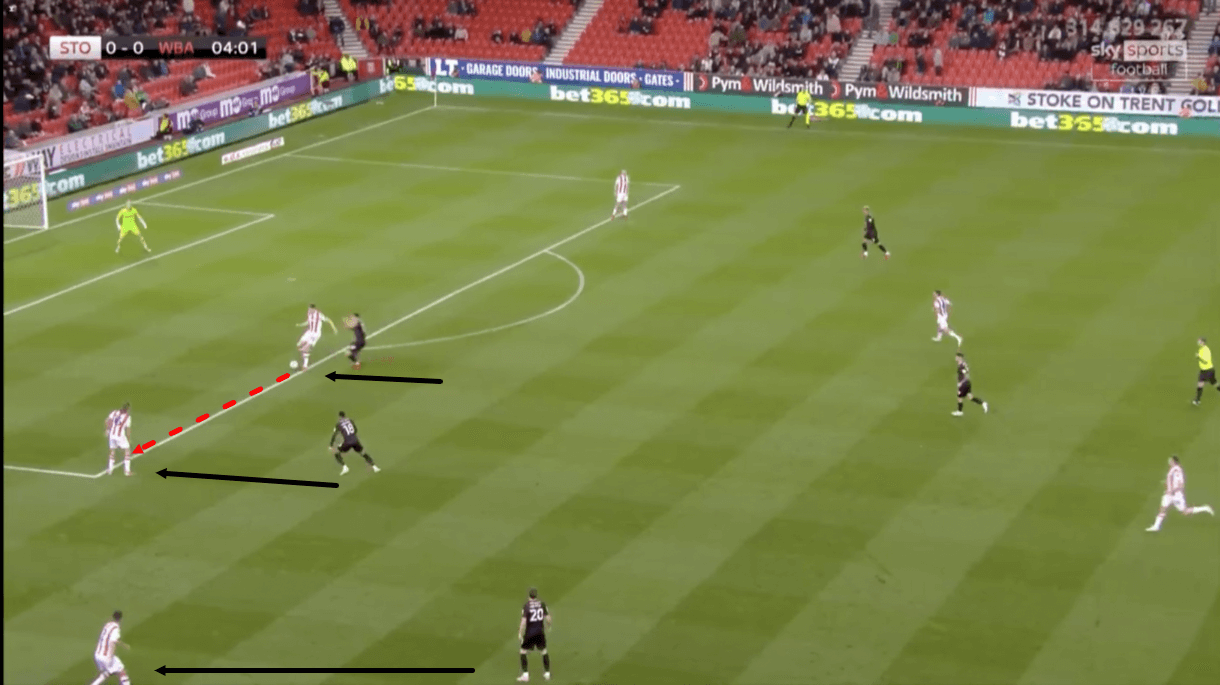
Instead, as we see in figure 14, Souttar sets himself to play with his right foot again and decides to pass the ball back to the right centre-back.
This leads to pressure increasing further on that player and leaves Stoke City in a worse position than they had been previously.
So, it’s clear that Souttar’s one-footedness can create a lot of problems for him and his team.
As a result, this is an area for the centre-back to focus on improving.
If he can become more confident with performing short passes on his left foot, like the ones that were possible in figure 13, then that could make his game even more well-rounded.
At present, this is a notable weakness, however.
Harry Souttar Defending
Souttar is a centre-back, so his bread and butter has to be what he contributes to the team without the ball, given his crucial central position in Stoke City’s last line of defence.
While some centre-backs are aggressive and enjoy hunting for the ball, actively seeking defensive duels, others take a more passive approach.
Souttar is more of the latter.
Although he likes to play the ‘hunter’ role for aerial duels, the 23-year-old is more cerebral with the rest of his defending, preferring to rely on his reading of the game, reactions and patience over speed and aggression.
The Australian doesn’t tend to engage in a lot of defensive duels.
In the last 12 months, he’s engaged in 5.26 defensive duels per 90 in England’s second-tier, which isn’t a particularly high number for a centre-back.
This isn’t a negative — just a result of his more passive approach.
However, Souttar has achieved a stellar 77.2% success rate with his 5.26 defensive duels per 90 over the last 12 months, which ranks very highly among Championship centre-backs.
Only six Championship centre-backs to have played at least 800 minutes in the league over the last calendar year have achieved a better defensive duel success rate than Souttar in England’s second-tier.
Souttar’s ability to read the game, along with his patient, more passive defensive style, is also highlighted by the fact that he’s made an impressive 6.76 interceptions per 90 in the league over the last 12 months, ranking him eighth in this particular metric among Championship centre-backs to have played at least 800 minutes during this period.
Regardless of whether it’s a two or three-man backline, Souttar would be best partnered with more aggressive centre-backs who actively seek defensive duels while the Australian aims to take a more passive approach, aiming to sweep up behind.
Another couple of areas in which the Stoke City man notably stands out are: he rarely makes fouls, averaging 0.51 fouls per 90 over the last 12 months, which ranks him very low among Championship centre-backs with over 800 minutes to their name, while he also tends to make a fairly high number of blocks, with Souttar averaging 0.59 blocks per 90 in the league over the last 12 months.
We’ll now provide some analysis of in-game examples of Souttar’s defending, looking at some notable traits of his without the ball, including some examples of 1v1 duels.
Firstly, it’s worth noting that for all of his physical traits and his impressive numbers in the aforementioned defensive metrics, one of Souttar’s weaknesses is his pace.
He’s not as slow as you might imagine for a 198cm man, but he still isn’t quick and can be beaten for pace in a straight-up foot race.
However, this weakness is very rarely exposed because Souttar has such a good reading of the game, good defensive positioning and makes intelligent decisions to compensate for pace.
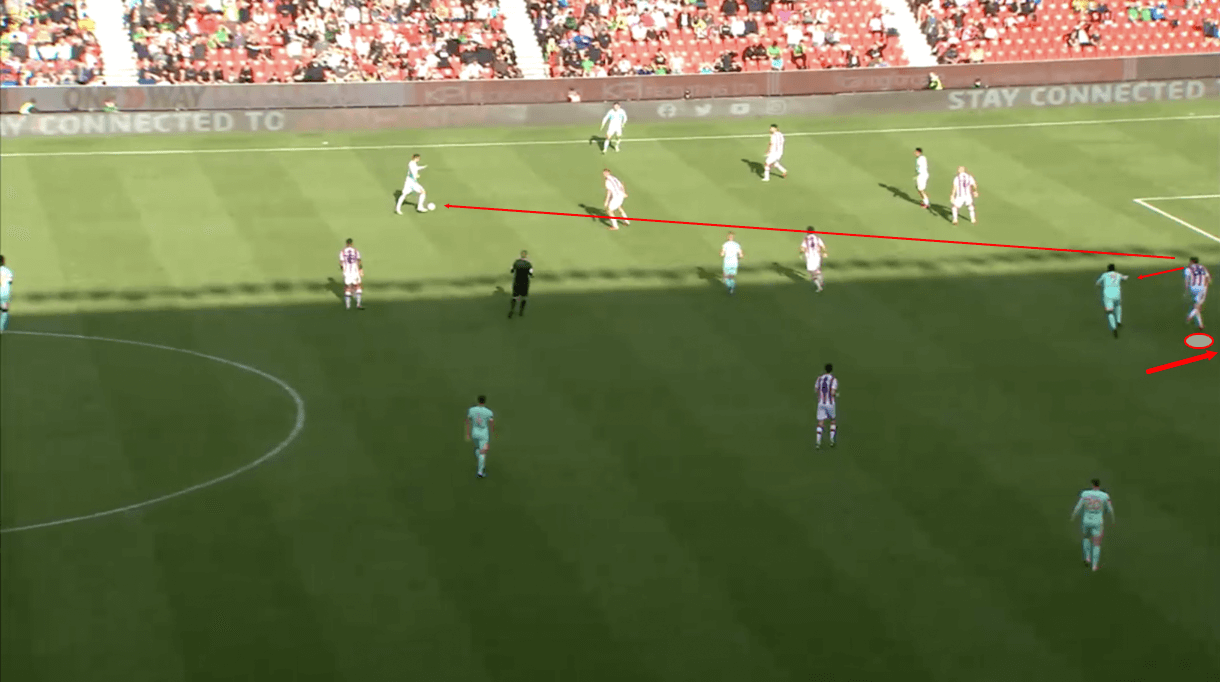
Teams are aware of Souttar’s pace and seemingly try to target it with balls in behind for runners to run onto.
Souttar tends to defend well against these attempts at exploiting his pace by remaining calm, positioning himself between the attacker and the goal, and not committing to a challenge, almost guiding the attacker into a mistake.
Another technique that Souttar uses to prevent teams from exploiting his lack of pace is dropping off when balls are played in behind the backline to an attacker to give himself an extra couple of yards, which we see an example of in figure 15.
Just before this image, Souttar was positioned tighter to the nearest opposition forward.
However, the Stoke man did well to spot the passer’s intent of playing a ball over the top for this player to run onto.
As the passer lifted his left foot to execute the pass, Souttar intelligently dropped off the attacker to buy himself an extra couple of yards.
As play moves on from this moment, the attacker receives the ball with nowhere to go.
He receives the ball with his back to goal, as he can’t run onto the pass because of Souttar’s positioning which also makes it impossible for him to turn.
The big Australian holds his ground well and positions himself well, blocking the attacker from moving towards goal and ultimately forces him backwards.
While a lack of pace was there for the opposition to exploit, Souttar did well to prevent this from happening by showcasing excellent defensive technique.
It’s common to see him intelligently drop off like this when spotting balls being played in behind.
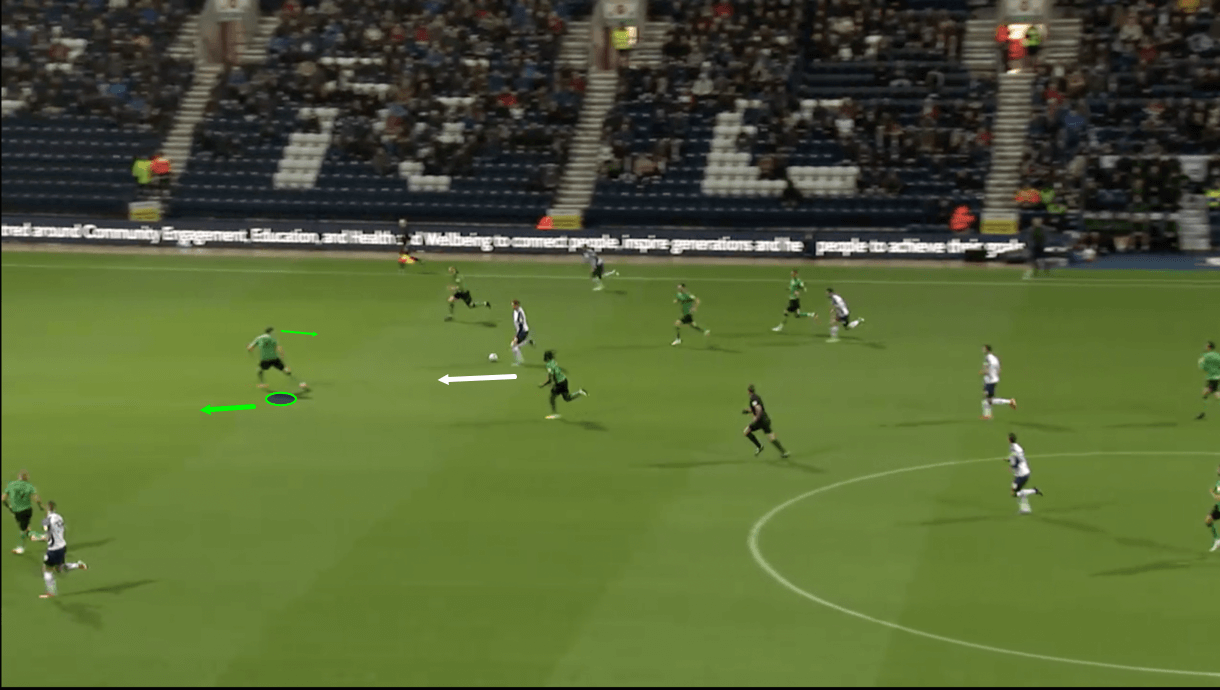
As a result of his more passive defensive nature, Souttar doesn’t end up getting dragged into a lot of 1v1 duels.
However, it can happen in moments of transition, with the opposition running at a weakened Stoke City backline and enjoying the opportunity to isolate defenders 1v1, while it can also happen if one of Souttar’s teammates opts to defend more aggressively, engaging the opposition attacker higher, and gets beat, leaving Souttar with the responsibility to cover for him.
Figure 16 shows an example of Souttar getting dragged into a 1v1 duel as the opposition counter-attack Stoke, running at Souttar in the centre.
This can happen on occasion and when it does, Souttar generally tends to conduct himself very well.
Firstly, again, he’s good at remaining calm in these situations, not rushing in to engage the attacker, focusing on retaining his positioning between the ball and the goal and backing off to guide the attacker into a mistake.
Souttar’s body positioning in figure 16 is excellent, as it generally tends to be.
We don’t see him getting caught square, running away from the ball, or at too much of an angle — he’s positioned side-on at roughly a 45-degree angle, ready to react to the attacker’s movement regardless of which side he targets while backing away and keeping himself between the attacker and the goal.
As play moves on here, Souttar continues to back off while the dribbler moves towards him until the attacker ultimately makes his move and tries to exit on the outside of Souttar, aiming to speed towards the byline on the outside of the centre-back.
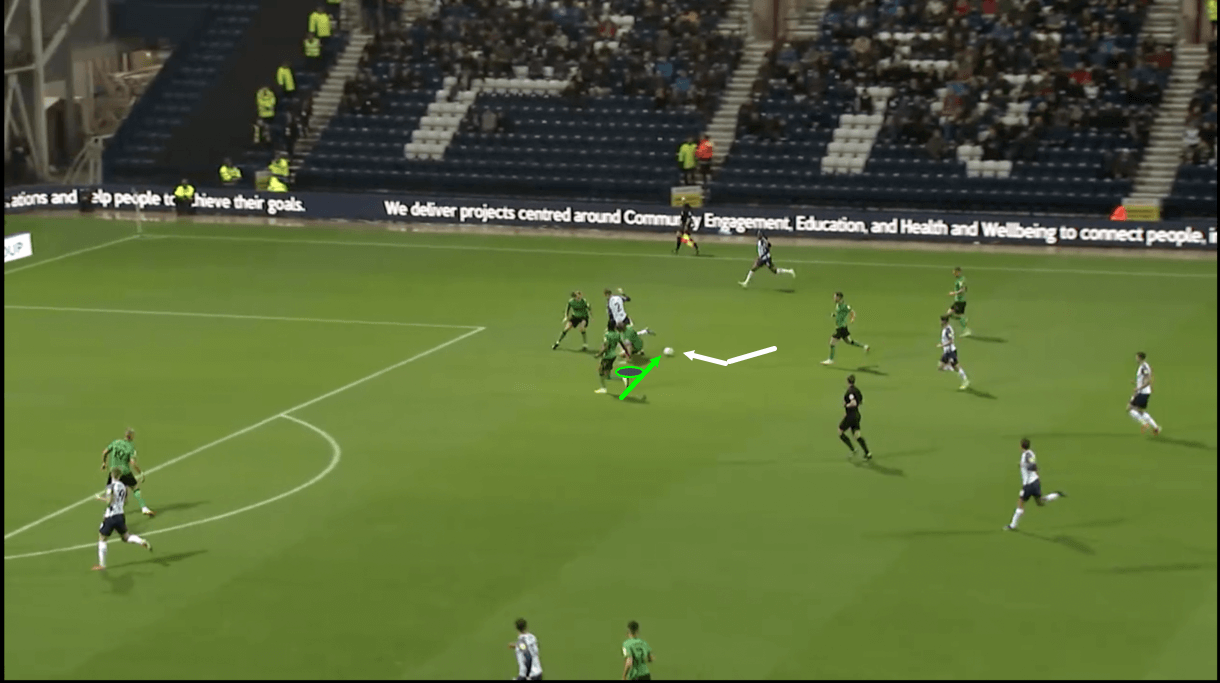
Again, the Australia international remains calm and composed.
He was waiting for the attacker to commit to attacking first and this was the commitment he’d been waiting for.
In figure 17, we see that as the attacker made his move on the outside, Souttar reacted excellently springing into action and performing a perfectly-timed tackle to dispossess the dribbler, end the opposition’s counter-attack and regain possession for Stoke.
Souttar could get caught out in 1v1s if his positioning, patience and reading of the game weren’t so good, as his agility isn’t amazing so he could get turned by a tricky dribbler and if he did, then he’d find it difficult to recover.
However, he doesn’t let this happen much because he’s constantly showcasing excellent fundamentals in his defensive play.
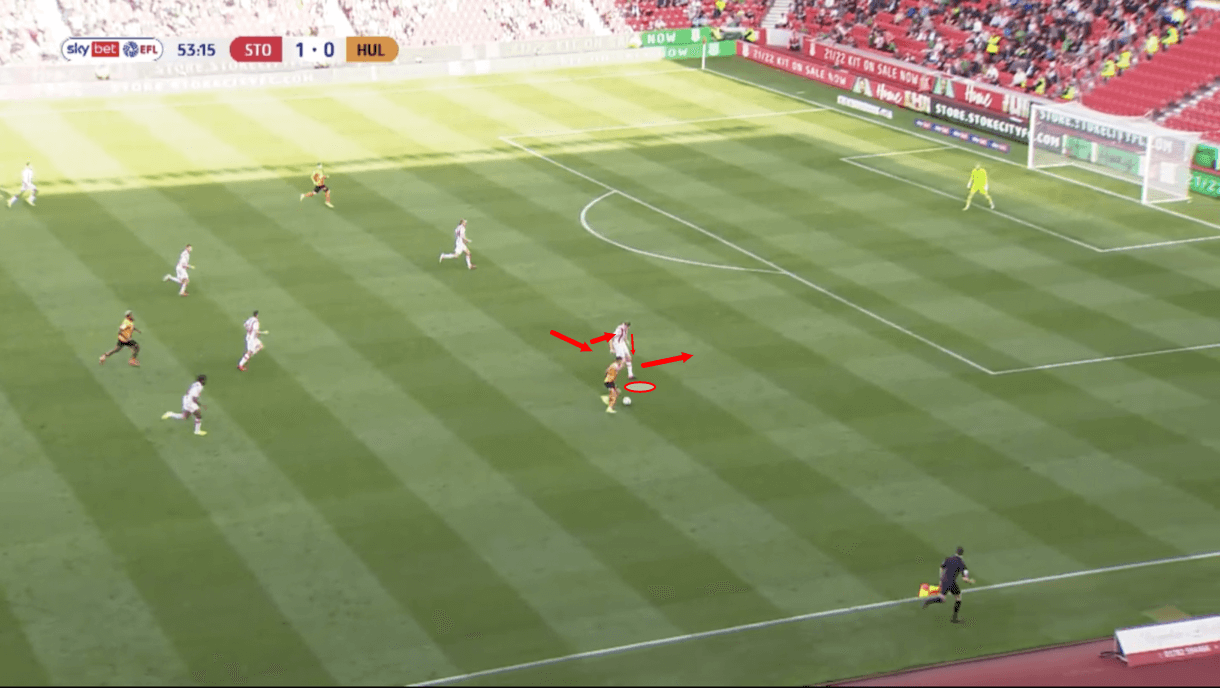
We see another example of Stoke getting caught on the counter, leaving Souttar responsible for cleaning up the mess by getting involved in a 1v1, in figure 18.
Just before this image, the opposition attacker was played through on goal and Souttar immediately exhibited some good defending by calmly coming over towards the left from the centre and positioning himself well, at a good angle between the attacker and the goal.
He gives the attacker almost enough space on the outside to try and knock the ball around him, knowing that he’s positioned at a good angle to react and could step across to make it very difficult for the dribbler to move past his large frame and he protects the inside well with his body positioning too.
This immediately forces the dribbler to move away from goal towards the wing.
Note Souttar’s eyes here as well — he’s focusing on the ball and the attacker’s lower body to watch where he’s going and anticipate his next movement.
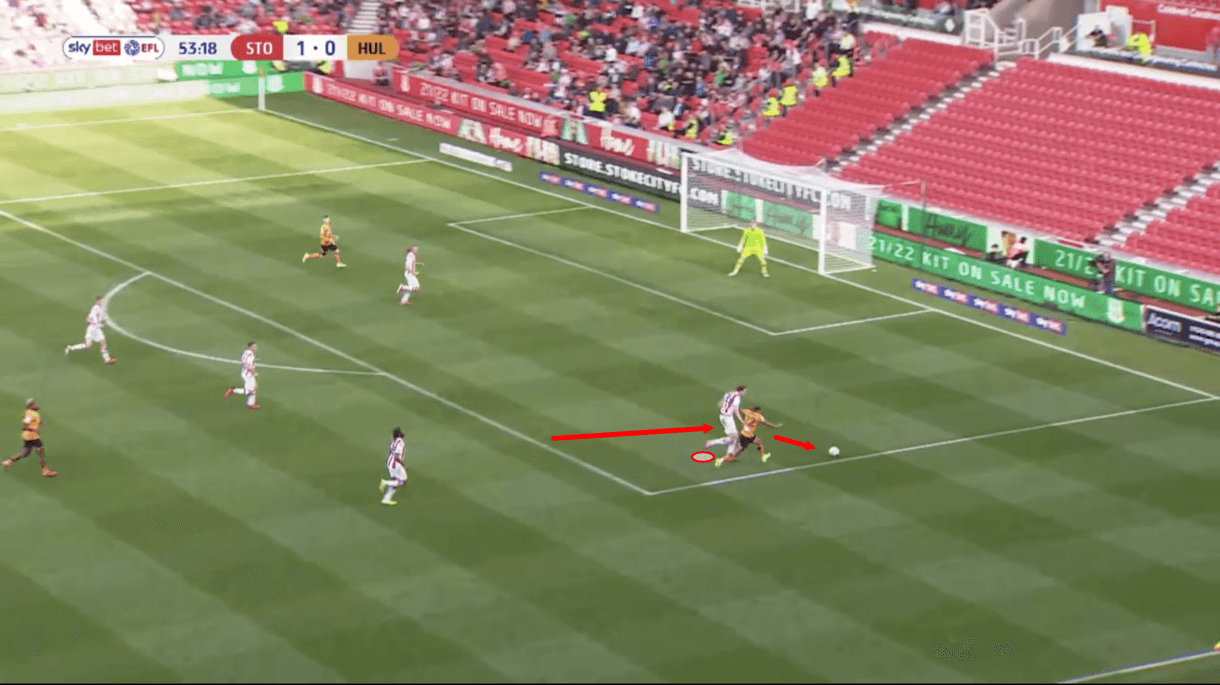
The defender doesn’t rush into a challenge — he just tries to deal with things in a calm and considered manner, focusing on doing the basics well and proceeding from there.
As play moves on into figure 19, we see that Souttar successfully shepherded the dribbler away from goal, down the wing while keeping his body positioned well to block the cross and deal with any attempt from the attacker to cut inside.
This highlights one reason why Souttar makes so many blocks — his good positioning and tendency to shepherd players into areas where they don’t have many options other than to try and play a shot/cross that the 23-year-old is positioned well to defend against.
Souttar still doesn’t dive in here, he just pressures the attacker while shepherding him away from goal and waits for a mistake, which we see in figure 19, as the attacker crumbles under pressure by taking a far too heavy touch.
Souttar sees this as his opportunity to pounce and suddenly jolts into action, performing a quick sprint to get himself between the man and the ball.
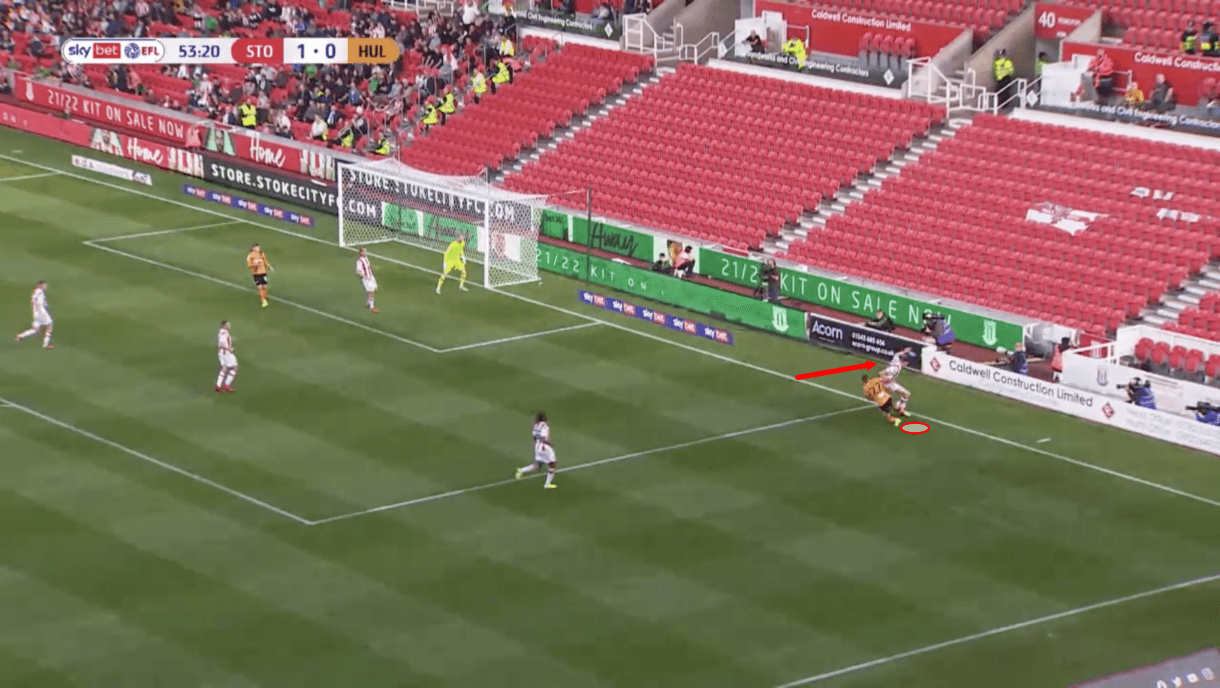
It’s very common to see a situation like this occur, as Souttar is very aware of his size and likes to use it to his advantage by getting between attackers and the ball, challenging them to try and move him, which they often fail to do, as was the case in this example.
In figure 20, we see that Souttar successfully held his ground between the man and the ball while guiding the ball out of play.
While the attacker tried to get around the 23-year-old, he is very big, strong and well built, so the task was too much and this once-promising attack results in a goal-kick for The Potters.
This attack was thwarted thanks to Souttar’s composed defending, led by good fundamentals and aided by his size and strength.
This makes him a formidable opponent for attackers in 1v1 duels.
While Souttar isn’t without any flaws, which we’ve discussed, he generally performs well 1v1.
Conclusion
To conclude our tactical analysis, Souttar is a very exciting player with a well-rounded skill-set.
He’s performed excellently in lots of areas on the ball, off the ball, and in the air.
His size is an obvious asset that will attract teams to him and it does help him off the ball and in the air.
However, he’s more than just a giant, Souttar is a very intelligent and technically sound player with and without the ball.
This is why Australia’s boss sees him playing at the pinnacle of English football in the future and why the likes of Everton, Tottenham Hotspur, and Aston Villa have all reportedly shown interest in signing the 23-year-old after just one season in the Championship.
I don’t think he’d look out of place at least competing for a spot at any of the aforementioned clubs and I do think, thanks to all the positives that we’ve discussed, that his future lies at the very top of the game, whether that’s in England or elsewhere.

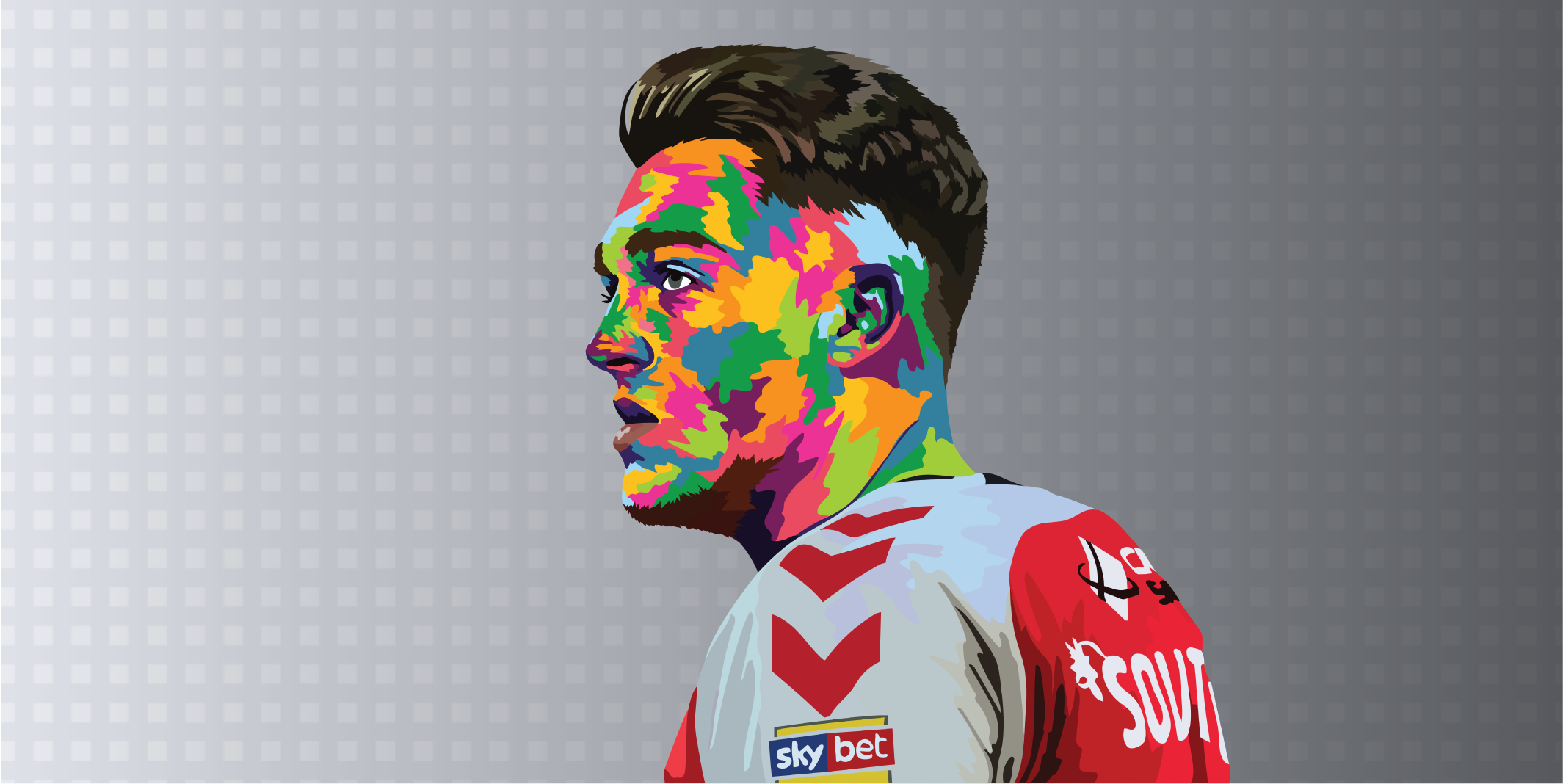



Comments